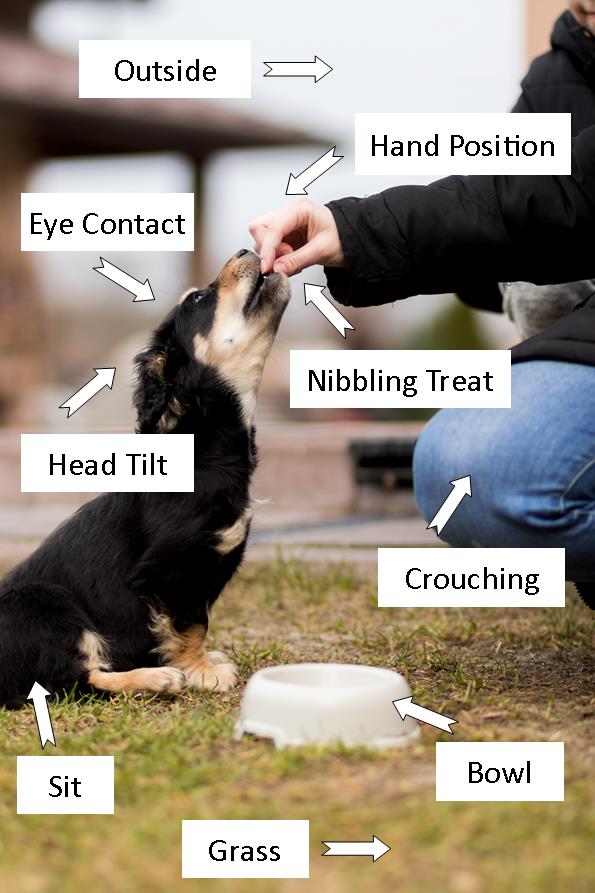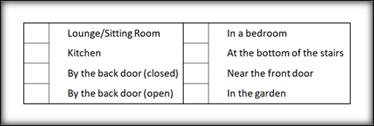Day One! Teach your first trick!
For most pups, the SIT is the first trick they learn. It’s a good choice as it can be used in a bunch of different ways. We’ll use it later in this course when answering the door. But it can also be useful anytime you need your pup to wait calmly, such as at the side of the road, in a cafe, while passing people or dogs, and while you prepare their food. It’s also a good way to check how your pup is feeling. If your pup can sit convincingly then you can be sure they are paying attention to you and are reasonably calm. A quick bum touch, or refusal, might indicate over excitement, frustration, or anxiety. Apart from the recall, the sit is the only cue your dog really needs! The rest are really useful, and have their own benefits, but you can get by without them!
Why is it important?
Teaching your pups first trick is not just about telling your dog what to do. It’s also about the bonding and learning process itself. When you teach your pup his first trick, he is also learning how to learn! During your first training session, your pup will learn how the process works, and crucially, if he likes it or not.
He will have no idea what is happening the first time you get the treats out to train him. He’ll think you’ve gone mad when you start waving your hand about in front of him, begging him to sit. Treats used to be free! So this will be the first time he has had to do anything to earn one. He’ll have to figure that out before he can even think about the trick you are attempting to teach him.
Don’t worry, you’ll only go through this once. Next time you get the treats out, he’ll know exactly what to expect, and will start trying to figure out what you want from the start!
Hopefully, your pups first training session is a positive and encouraging experience, as he’ll remember it for the rest of his life. Using treats and encouraging words means he’ll want to learn from you in the future and he’ll attempt new things with extra confidence. This mindset is important and will effect how he learns for the rest of his life. Dogs that feel loved and supported during early training learn everything faster and more permanently. That includes house training, general obedience, recall, and your household routines. They are more confident overall, and cope better in new situations, and when left alone. Win-Win-Win-Win etc!
Saying all that, if you did get off on the wrong foot, it’s not too late to change things. Keep things super positive, and the next two weeks will bring you back together!
So how does it work?
When you teach a new trick to your dog, you’ll start by luring them into the position you are aiming for. I often use a treat for this, but you might find your dog achieves it without any lure. Failing that, you could use a toy, an obstacle to go over or under, your hands, a lead, or you could just wait for it to happen naturally. Please be gentle as you guide your pup into different positions though. Hands and leads should always be associated with gentle, loving touch and never something to avoid or fear. For example, it’s ok to put your hand behind your dog to stop them reversing away, or use a lead to guide them past something, but it’s not ok to push them down, or yank the lead! In fact, pushing them into a position can worsen frustration based behaviours like mouthing, chewing at door frames, barking when in a separate room, and grabbing at leads, which are much more difficult problems to solve.
It’s not just about the trick, you’ll also need a way to let your dog know he’s done it right. Treats work for most, and praise can boost the impact of the reward. Or you could use toys or praise alone. Most tiny pups aren’t too fussy when it comes to rewards so you could use their normal food at this stage. As they grow up, they might start to show a preference though, so we’ll come back to that later in this course.

Teaching Sit
- Place a treat between your fingers
- Hold the treat close to your dogs nose so he can lick and sniff it
- Slowly move the treat over the pups head, in an arc, towards the tail.
- Your pups body will tilt as his nose follows the treat and his bum should touch the floor
- Let go of the treat and celebrate with a “good boy”
- Repeat in different rooms, the garden, in the boot of the car, and with different people to eliminate unrelated associations.
- When your pup finds this easy, then you can add the command word!
What could go wrong?
He/she reverses when you move the treat over their head! You moved your hand too quickly. Slow it down and make sure they stay engaged with the treat as you move it.
He nibbles your fingers. This happens a lot as your pup is used to getting free treats. He’ll stop once he realises what he has to do. If it’s bad, consider wearing gloves for this bit.
Back to the trick!
The first few times your pup gets a reward for sitting, he’ll not be sure what he did correctly. So, he’ll try out lots of different options while he figures it out. In the picture above, you can see exactly what the pup might think you want. The more he practises the more he’ll eliminate the incorrect associations and narrow it down to sit = bum on floor!
While he goes through this elimination process it’s important that you are clear what you want, and consistent with your rewards. For the sit, keep it simple and reward him every time his bum touches floor. It doesn’t matter where he is looking, how close he is to you, if he is nibbling your fingers, or not. He also doesn’t have to do it for long, just long enough that you are sure they actually did it! You can make it fancy later!
So, if you haven’t already, above is a description of how I teach sit. Or if you prefer, there are a million videos on YouTube that will show you how to do this. Just keep it light, positive, and help him out as much as possible. It is not a trial, so don’t put too much pressure on him. If you don’t succeed the first time, try again later. Pups learn better at different times of the day. It’ll take some experimentation to figure out your pups best time, but we’ll come to that in a few days too!
He hasn’t learned it yet…
Just because he’s done it right a few times, doesn’t mean he’s learnt the trick though! Learning the bones of the trick is only the first stage. Next you’ll need to add some distractions and more locations, so don’t worry if he’ll not do it perfectly every time yet. That will come the more you practise, and with consistency – I’ll tell you more about how that works tomorrow. But for now just keep practising.
When he’s fully vaccinated, you’ll be able to start practising in new locations, and with some real life distractions! But, you might have a few distractions at home that you can practise on such as when you have visitors, if kids are laughing and playing nearby, or your neighbours are in their garden!
Puppy Classes
Whilst it is true that a sit and recall are the most important tricks, you don’t have to stop there. Learning new tricks and tasks together can be lots of fun and very rewarding. As long as it is positive, it’ll help bond you together, and you’ll feel more in control later on. If further obedience training is something that interests you then now is the perfect time to start looking for a local class to enroll on, some may have a waiting list. Before you commit though, please do your research into the kinds of techniques they use. There is absolutely no reason to use harsh methods like lead jerking, choke chains, or punishments to train a puppy. See what people are saying about the classes they run on social media, or talk to the trainer in advance. Some might even invite you to watch a class before you commit. In particular, be wary of trainers that describe themselves as balanced or minimal force, this is just a fancy way of describing aversive methods.
Here’s todays task! See you again tomorrow…
Today’s Task
Teach the sit in the place your pup spends the most time, he’ll be at his most relaxed there! Now practise your sit in as many different locations as possible. As your pup is not fully vaccinated yet, you’ll be restricted to the rooms he has access to, and your garden. Also try to keep sessions short; 5-10 minutes at a time will be more than enough for his puppy brain!
Here’s my checklist for location ideas to practise in, but you can add your own…
